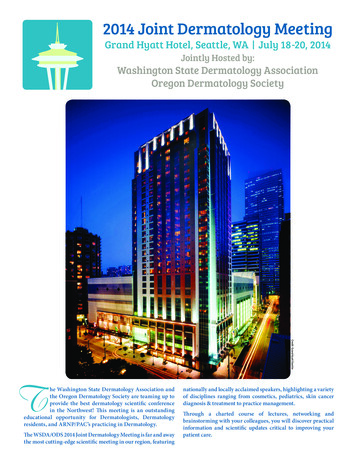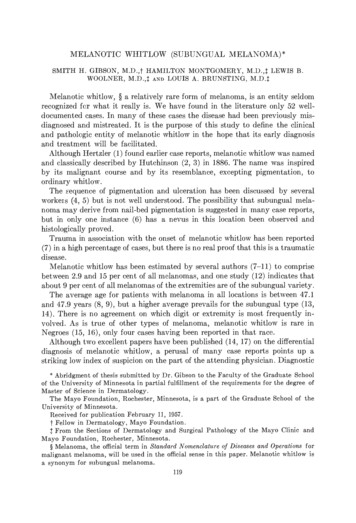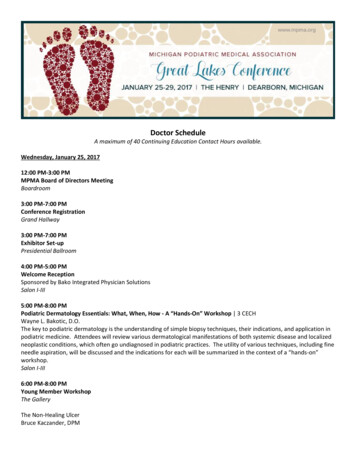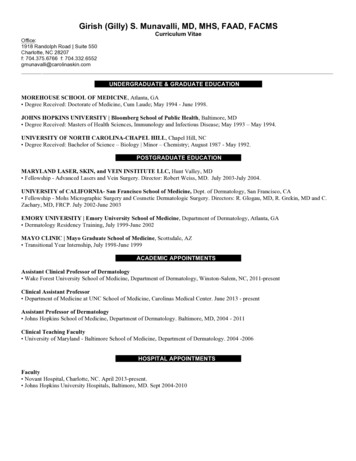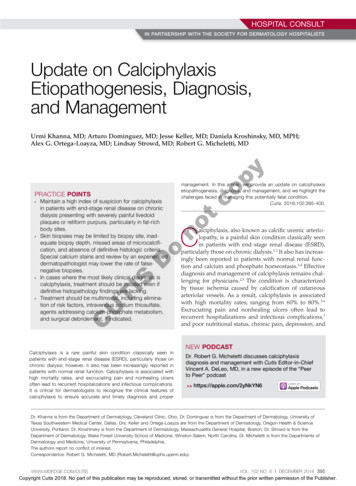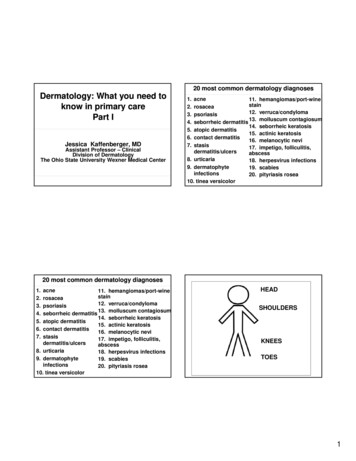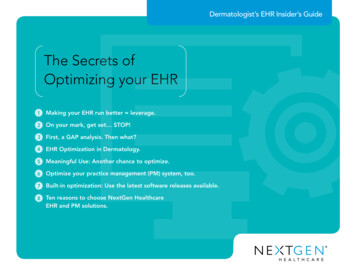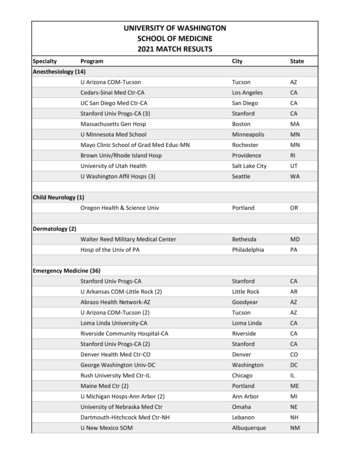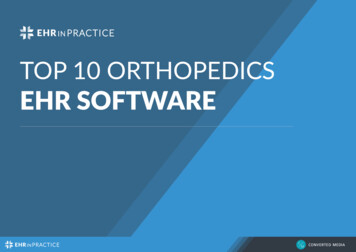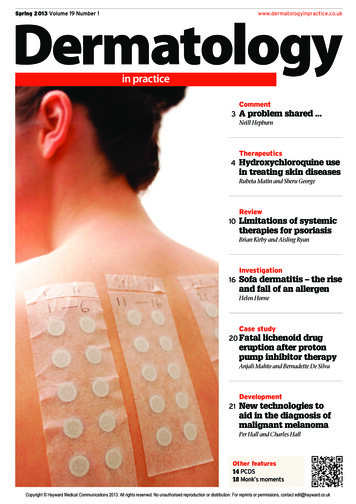
Transcription
Spring 2013 Volume 19 Number 1www.dermatologyinpractice.co.ukDermatologyin practiceComment3 A problem shared .Neill HepburnTherapeutics4 Hydroxychloroquine usein treating skin diseasesRubeta Matin and Sheru GeorgeReview10 Limitations of systemictherapies for psoriasisBrian Kirby and Aisling RyanInvestigation16 Sofa dermatitis – the riseand fall of an allergenHelen HorneCase study20 Fatal lichenoid drugeruption after protonpump inhibitor therapyAnjali Mahto and Bernadette De SilvaDevelopment21 New technologies toaid in the diagnosis ofmalignant melanomaPer Hall and Charles HallOther features14 PCDS18 Monk’s momentsCopyright Hayward Medical Communications 2013. All rights reserved. No unauthorised reproduction or distribution. For reprints or permissions, contact edit@hayward.co.uk
DERMALTO P I CA L I N N OVATIONFOR E VE RY B O DY2013 sees Dermal celebrate 50 years of successful topical innovation.This extensive experience in developing highly effective, yet cosmetically eleganttreatments for application to the skin, has benefited millions of people for half a century.Dermal remains committed to building on that success for the benefit of future generations.Dermal Laboratories Limited, Tatmore Place, Gosmore, Hitchin, Herts, SG4 7QRwww.dermal.co.uk
CommentDERMATOLOGY IN PRACTICE 2013; Vol 19 No 1Neill Hepburn Md frCPConsultant dermatologist,Lincoln County hospital.Editorial BoardW Iain F Henderson MB ChB drCOG dPdGP Principal, Glasgow; hospital Practitioner,Glasgow Western Infirmary.Danny Kemmett MB ChB frCP(edin)Consultant dermatologist,royal Infirmary of edinburgh.Barry E Monk Ma frCPConsultant dermatologist,BMI the Manor hospital, Bedford.Tom Poyner frCP(Lond) frCP(Glasg) frCGP dPdGP, Stockton-on-tees; honorary Lecturer,University of durham.Jane Watts rGN eNB 393 998Senior dermatology Nurse,Whipps Cross Universityhospital, London.Irshad Zaki BMed Sci(hons) BM BS MrCPConsultant dermatologist,Solihull hospital.Published byHaywardMedicalCommunicationsa division of hayward Group Ltdthe Pines, fordham road,Newmarket CB8 7LG, UK.Tel 44 (0)1638 723560.Fax 44 (0)1638 723561.email admin@hayward.co.ukwww.hayward.co.ukPublisher Mary read.Editorial Director robin Jones.Senior Sub EditorsKirstin Knight and anne-Claire BouzanneSub Editor Claire robertson.Editorial Assistant Josie Mitchell.Art Editor richard Seymour.Publications manager andrea Bucceri.the data, opinions and statementsappearing in the articles herein are thoseof the contributor(s) concerned; they arenot necessarily endorsed by the sponsors,publisher, editor or editorial Board.accordingly, the sponsors, publisher, editorand editorial Board and their respectiveemployees, officers and agents acceptno liability for the consequences of anysuch inaccurate or misleading data,opinion or statement.Design & Editorial Officehayward Medical Communications,8–10 dryden Street, Covent Garden,London WC2e 9Na.tel: 44 (0)207 2404493.fax: 44 (0)207 2404479.email: edit@hayward.co.ukthe title Dermatology in practice is theproperty of hayward Group Ltd and,together with the content, is boundby copyright. 2013 hayward Group Ltd.all rights reserved.ISSN 2049-8446 (Print).ISSN 0262-5504 (Online).Printed by Williams Press Ltd.Cover picture Science Photo LibraryA problem shared .‘When it is obvious that the goalscannot be reached, don’t adjustthe goals, adjust the action steps.’ConfuciusWhen I came to work inLincolnshire 16 years ago,initially as a single-handed consultant,I had two principal concerns. First,what would I do when I did not knowthe diagnosis? Second, how I wouldcope with those patients with chronic,intractable dermatoses – patientswith nodular prurigo, palmoplanterpustulosis, difficult atopic eczema,or severe psoriasis? I felt much betterabout the first group after recallingthe kind and wise words of the greatDr John Savin, who taught me as aSenior Registrar in Edinburgh. I had justfinished my final dermatology clinicbefore leaving to become a consultant.I, somewhat ruefully, remarked, ‘I’ve justdone my last clinic and I haven’t got a cluewhat was wrong with four of the patients’.Dr Savin responded along the lines of, ‘Don’tworry, I’ve been doing dermatology for over30 years and it keeps happening to me –that’s the fascination of dermatology!’ Well,after 20 years of practising dermatology,the fascination persists!The second group of patients pose adifferent problem. I feel a mixture ofinadequacy and frustration that I am unable to‘cure’ them or, at least, relieve their symptomseffectively. Aligned to this is a sneaking fearthat I may not have made the correctdiagnosis. These patients, who I generally referto as my ‘old friends’, muddle along with me aswe try one partially-effective treatment afteranother – often wondering if any improvementwe find is simply an observation of theircondition remitting spontaneously – that is,regressing to the mean.The most valuable asset here is working as ateam. The old adage that ‘a problem shared is aproblem halved’ is certainly true. I have workedin a team of dermatologists in Lincolnshire forover ten years and I would be very reluctant toventure out alone again. The availability ofcolleagues to pop in to the consulting room, sowe can see patients together, is invaluable.While I enjoy the relative peace and quiet ofmy clinics in the rural community hospitals,where I am often working on my own, I have Chad J. Shaffer/GettyEditor having colleagues on hand to help advise on diagnosisand treatment is an invaluable asset for a dermatologist tohave in the workplacethe constant reassurance of knowing thatthe patients can come along to the combinedclinic that we hold in Lincoln every month,so they can see a ‘proper’ dermatologist.My work programme changed a fewmonths ago, reducing the number of myweekly clinics from seven down to four, as Itook up some administrative tasks as a parttime deputy medical director. Some of thepatients I had been looking after,intermittently, for many years turned upin my colleagues’ clinics and then found theirway to the combined clinic. So, on a recentThursday afternoon, we listened to thepatients’ stories, examined them togetherand formulated a treatment plan for thenext few months – as doctors do. The realvalue was in the support we derived fromeach other, together with the reassurance itgave to our patients.With the advent of clinical commissioninggroups, the advent of modern technology andthe move to managing more patients in thecommunity, we need to work together toprovide this support more readily acrossthe whole healthcare community. Ourchallenge is how to bring it about. Neill Hepburn, Editorwww.dermatologyinpractice.co.ukCopyright Hayward Medical Communications 2013. All rights reserved. No unauthorised reproduction or distribution. For reprints or permissions, contact edit@hayward.co.uk3
TherapeuticsRubeta MatinPhD MRCP SpecialistRegistrar inDermatologySheru GeorgeMBChB FRCP ConsultantDermatologist,Department ofDermatology,Churchill Hospital,OxfordDERMATOLOGY IN PRACTICE 2013; Vol 19 No 1Hydroxychloroquine usein treating skin diseasesAntimalarials are used by dermatologists totreat various skin conditions (see Table 1). Sincethe 1950s, the 4-aminoquinolone derivative ofquinine, hydroxychloroquine, has been widelyused in dermatology, in preference to chloroquine. Compared with other immunosuppressant medications used to treat inflammatoryskin conditions, hydroxychloroquine is considered safer with a more favourable side-effectprofile. This article aims to summarise the usesand adverse effects of hydroxychloroquine andthe monitoring of dermatological patients prescribed the drug.Indications for useLupus erythematosusHydroxychloroquine is considered first-linesystemic therapy in most cutaneous forms oflupus. According to a 1963 review, discoid lupuserythematosus (LE) responded so favourably tochloroquine that ‘double-blind studies were notrequired’,1 and a non-randomised double blindtrial of hydroxychloroquine versus placebodemonstrated significant responses at threemonths, persisting for one year.2 Large open clin-ical trials have demonstrated benefit of hydroxychloroquine in chronic and subacute cutaneousLE.3,4 Lupus tumidus and lupus panniculitisare reported to improve with hydroxychloroquine.5,6 Verrucous, or hypertrophic, plaques areless responsive.Treatment also improves non-specific featuresin patients with systemic LE (SLE), such aslethargy/fatigue, arthralgia/myalgia, serositis,mucous membrane ulceration, calcinosis cutisand photosensitivity.7 The number of flare-ups inSLE is reduced and improved overall survival rateshave been reported.8,9 Antimalarials also appearto lower lipid levels in SLE, suggesting a furthercardioprotective role, in addition to loweringrates of thrombosis.10The standard dose of hydroxychloroquine forcutaneous LE is 200–400 mg daily.11 In some cases,doctors prescribe a loading dose and then reduceto a lower maintenance dose. It is also often usedin combination with mepacrine (quinacrine), another antimalarial drug, when patients are unresponsive to hydroxychloroquine alone. It is wellrecognised that smoking inhibits the therapeuticeffect, and patients must be counselled regardingthis prior to starting the medication.12Table 1. Clinical uses of hydroxychloroquineGroupConnective tissue diseasesGranulomatous skin conditionsPhotodermatosesHair disordersGenodermatosesOther4Dermatological conditionLupus erythematosus Systemic Subacute cutaneous Discoid Tumidus PanniculitisSjogren’s syndromeSclerodermaCutaneous sarcoidosisGranuloma annulareNecrobiosis lipoidicaPolymorphic light eruptionPorphyria cutanea tardaSolar urticariaLichen planopilarisFrontal fibrosing alopeciaEpidermolysis bullosaUrticarial vasculitisEosinophilic fasciitisChronic ulcerative stomatitisReticular erythematous mucinosisPolymorphic light eruptionPolymorphic light eruption is a photodermatosisthat mostly occurs in young women. It ischaracterised by itchy skin lesions of variablemorphology, occurring mostly in spring or earlysummer on sun-exposed body sites. The pathogenesis may involve resistance to ultraviolet lightradiation-induced immunosuppression. Although hydroxychloroquine is not consideredfirst-line treatment, two controlled efficacytrials13,14 have reported increased sun tolerance,moderate clinical improvement and a significantreduction in rash with hydroxychloroquine. Therecommendation is that in the event of failure offirst-line treatments or contraindications, hydroxychloroquine can be given at a dose of 200–400 mg daily, prior to attempting an increase insun exposure.Porphyria cutanea tardaPorphyria cutanea tarda (PCT) is characterised byphotosensitivity, with skin blistering and scarringfollowing exposure to sunlight. The primarywww.dermatologyinpractice.co.ukCopyright Hayward Medical Communications 2013. All rights reserved. No unauthorised reproduction or distribution. For reprints or permissions, contact edit@hayward.co.uk
No other emollients perform quite like them!Doublebase – The difference is in the GELSOriginal emollient GelEnhanced emollient GelhHig cerolgly t &oil onten ec idonpovhHig tenton rolclio lyce g Emolliency like an ointment Cosmetic acceptability like a cream Highly emollient long lasting protection As little as twice daily applicationDoublebase GelDoublebase Dayleve GelTMTMIsopropyl myristate 15% w/w, liquid paraffin 15% w/wRx by name for formulation of choiceDoublebase Gel Isopropyl myristate 15% w/w, liquid paraffin 15% w/w. Uses: Highlymoisturising and protective hydrating gel for dry skin conditions. Directions: Adults, childrenand the elderly: Apply direct to dry skin as required. Doublebase Dayleve Gel Isopropylmyristate 15% w/w, liquid paraffin 15% w/w. Uses: Long lasting, highly moisturising andprotective hydrating gel for dry skin conditions. Directions: Adults, children and the elderly:Apply direct to dry skin morning and night, or as often as necessary.Contra-indications, warnings, side effects etc: Please refer to SPC for full details beforeprescribing. Do not use if sensitive to any of the ingredients. In the unlikely event of a reactionstop treatment. Package quantities, NHS prices and MA numbers:Doublebase Gel: 100g tube 2.65, 500g pump dispenser 5.83, PL00173/0183.Doublebase Dayleve Gel: 100g tube 2.65, 500g pump dispenser 6.29, PL00173/0199.Legal category: P MA holder: Dermal Laboratories, Tatmore Place, Gosmore, Hitchin, Herts,SG4 7QR. Date of preparation: November 2012. ‘Doublebase’ and ‘Dayleve’ are trademarks.Adverse events should be reported. Reporting forms and information can befound at www.mhra.gov.uk/yellowcard. Adverse events should also bereported to Dermal.www.dermal.co.uk
Therapeuticscause is a deficiency of uroporphyrinogen decarboxylase, an enzyme in the heme synthesis pathway. This can occur as a result of inheriteddeficiency of the enzyme, although a number ofrisk factors can both cause and exacerbate thesymptoms of the disease; for example, excess alcohol intake and hepatitis C. Management includes reduction of excess iron through repeatedphlebotomy. Low-dose hydroxychloroquine(100 mg twice weekly) is used to achieve longterm remission of disease, with dose adjustmentsaccording to clinical response. In patients withPCT, antimalarials are reported to cause an acutehepatitis, so regular liver function test monitoringshould be undertaken.Cutaneous sarcoidosisFor cutaneous sarcoidosis, hydroxychloroquineappears to be an effective alternative to corticosteroid therapy, although there are no reportedrandomised controlled trials to support this. Anopen clinical trial reported 12 out of 17 individuals with regression of cutaneous sarcoidosiswithin four to 12 weeks of treatment with 2–3mg/kg daily.15DermatomyositisCutaneous lesions in dermatomyositis often failto respond to oral corticosteroids. Hydroxychloroquine is reported to be useful for cutaneous involvement,16 particularly in patients unresponsiveto corticosteroids and in those with amyopathicdermatomyositis.17 Combination antimalarials(with mepacrine) are also reported to be useful.Lichen planopilaris/frontal fibrosing alopeciaLichen planopilaris (LPP) is a scarring lymphocytic alopecia, and frontal fibrosing alopecia is avariant of LPP that primarily involves the scalphair over the frontal hairline and occurs in postmenopausal women. Symptoms and signs ofboth of these conditions are reported to respondto hydroxychloroquine.18Other conditionsOther skin conditions in which hydroxychloroquine may be used include: disseminated granuloma annulare, chronic ulcerative stomatitis, solarurticaria and Sjogren’s syndrome.ContraindicationsThe only absolute contraindications are hypersensitivity and a history of retinopathy. Relativecontraindications are glucose-6-phosphate dehydrogenase (G6PD) deficiency and neuromusculardisorders, such as myasthenia gravis and psychotic disorders.6DERMATOLOGY IN PRACTICE 2013; Vol 19 No 1Table 2. Adverse effects of hydroxychloroquineToxicityOcularSigns and symptomsReversibleIrreversiblePrecipitation of the drug in the cornealepithelium in diffuse punctate or whorl-likepattern, which gives rise to visual halosFine pigmentary stippling of the maculaLoss of the foveal light reflex‘Bulls-eye’ maculopathyLoss of visual acuityPeripheral visual field lossHaematologicalLiverCardiacLeucopenia (rare)Transient transaminitisCardiac conduction defectsCardiomyopathyMusculoskeletal Proximal or generalised myopathySkinBlue-grey pigmentation in patients (10–30%) on long-term treatmentPruritusMorbilliform exfoliative dermatitisDrug reaction with eosinophilia and systemic symptomsFlare of hloroquine is absorbed in the gastrointestinal tract and it undergoes renal elimination.It is N-demethylated by cytochrome P450 enzymes. Genotype variation in these enzymescould affect efficacy or toxicity. Maximum clinicalefficacy can take from three to six months toachieve. Efficacy has been demonstrated, in patients with SLE, to correlate with the drug’s bloodconcentration.19 A large variabilityMaximum clinicalin blood drug concentrations hasefficacy can takebeen reported, with higher concentrations demonstrated in patientsfrom three to sixwith inactive disease, comparedmonths to achievewith those with active disease, andalso a reported association with complete remission of disease.20,21 Based on these findings, wholeblood concentrations in excess of 1,000 ng/ml arerecommended. Unfortunately, most NHS laboratories are not able to routinely monitor hydroxychloroquine levels.Mechanisms of actionPotential mechanisms of action have beenextensively reviewed, and include intercalationinto DNA, phospholipase inhibition, antioxidantactivity and inhibition of inflammatory cytokines.22,23 Hydroxychloroquine accumulates inlysosomes, leading to a rise in pH, which inhibitsprotease activity, resulting in decreased intracellular processing, glycosylation and secretionof proteins.24–26 It inhibits stimulation of Toll-likereceptors, involved in activation of the innateimmune system, which may explain its efficacywww.dermatologyinpractice.co.ukCopyright Hayward Medical Communications 2013. All rights reserved. No unauthorised reproduction or distribution. For reprints or permissions, contact edit@hayward.co.uk
TherapeuticsDERMATOLOGY IN PRACTICE 2013; Vol 19 No 1in the treatment of inflammatory conditionssuch as LE.27Adverse effectsOcular toxicityThe incidence of ocular toxicity is reported tobe around 50 cases in approximately one millionpatients treated with hydroxychloroquine (May2005).28 In the largest single case series (follow-upafter seven years), one case was reported in 1,207treated patients.29 In a prospective study of patients treated for more than six years, a total of twoout of 400 cases of irreversible hydroxychloroquine retinopathy were observed.30 The risks ofretinal toxicity are much lower with hydroxychloroquine when compared with chloroquine,and these are detailed in Table 2. The British Association of Dermatologists and The British Societyfor Rheumatology have issued guidelines in conjunction with the Royal College of Ophthalmologists, recommending screening for patients onhydroxychloroquine, including visual assessments at baseline.28HaematologicalAntimalarials used in patients with G6PD deficiency are reported to cause haemolysis. Althoughit is a rare outcome, leucopenia has been reported.Haematological adverse effects are largely reversible after cessation of therapy. Recommendations for monitoring include full blood count atbaseline and then monthly for three months, followed by three-monthly tests.Gastrointestinal side-effectsGastrointestinal symptoms occur infrequently inpatients treated with hydroxychloroquine (10%)and include nausea, vomiting and diarrhoea.Symptoms are usually transient and resolve withtime or decreased dosage. Liver function testsshould be taken at baseline and then measuredmonthly for three months, followed by four to sixmonthly monitoring.Cardiac adverse effectsCardiotoxicity has been reported, in rare instances,and is potentially fatal. Restrictive cardiomyopathyand conduction defects have been reported whenhydroxychloroquine is used to treat various rheumatic conditions in which the skin is involved; forexample, SLE and ced myopathy isuncommon and often difficult to diagnose. Itshould be considered if there is unexplained evidence of myopathy, such as elevated muscle en-Box 1. Monitoring of patients takinghydroxychloroquine (adapted fromBritish Association of Dermatologists/British Society for Rheumatologyguidelines)28 Maximum dose should not be 6.5 mg/kg;total 200–400 mg dose daily Check renal and liver function at baseline Enquire about visual impairment not correctedby spectacles (at baseline and at annual review) Record reading performance with each eye(with glasses if worn) using a near vision test(baseline and annual review)zymes (creatine kinase), proximal or generalisedmuscle weakness, or chest pain. In patientstreated for rheumatic diseases, the prevalence isreported to be 12.6% (n 15 out of 119),34 but canbe as high as 46% (n 7 out of 15) in patientstreated for cutaneous diseases (LE/granuloma annulare cohort).35Monitoring of patientson hydroxychloroquineRecommendations for monitoring of patientsbeing treated with hydroxychloroquine are summarised in Box 1.28 In the occurrence of visualimpairment, the management options are: Referral to optometrist. If the impairment is correctable with refraction, then the patient cancommence treatment. Referral to ophthalmologist (while on treatment). This can be an onward referral from anoptometrist: if there is evidence of reduced vision (especially for reading); if the patient re-Key points Hydroxychloroquine is a well establishedand widely used treatment in dermatology. Side-effects are uncommon, but cliniciansshould be alert to any new symptoms notexplained by the patient’s condition. Ocular toxicity is much rarer thanwith chloroquine, but referral to anophthalmologist is recommended ifthere are concerns. Use of hydroxychloroquine in systemiclupus erythematosus has multiple benefits,including a possible cardioprotective role,but smoking inhibits the therapeutic effect. Unexplained chest pain or lethargy inpatients taking hydroxychloroquine canbe a sign of adverse cardiotoxic effectsof the drug.www.dermatologyinpractice.co.ukCopyright Hayward Medical Communications 2013. All rights reserved. No unauthorised reproduction or distribution. For reprints or permissions, contact edit@hayward.co.uk7
Therapeuticsports patchy central vision; or if the patient reports distorted central vision. Weaning patient off drug to avoid disease flare.ConclusionHydroxychloroquine is an effective treatment formany cutaneous diseases. Its range of uses amongdermatologists continues to broaden. Althoughside-effects are uncommon, patients must beadequately consented when treatment is commenced. Most adverse effects will resolve on discontinuation of the treatment Declaration of interestNone declared.References1. Rees RB, Maibach HI. Chloroquine. A review of reactions and dermatologic indications. Arch Dermatol 1963; 88: 280–289.2. Kraak JH, van Ketel W, Prakken JR, van Zwet W. The value of hydroxychloroquine (plaquenil) for the treatment of chronic discoid lupus erythematosus; adouble blind trial. Dermatologica 1965; 130: 293–305.3. Callen JP. Therapy of cutaneous lupus erythematosus. Med Clin North Am 1982;66: 795–805.4. Furner BB. Treatment of subacute cutaneous lupus erythematosus. Int J Dermatol 1990; 29: 542–547.5. Kreuter A, Gaifullina R, Tigges C et al. Lupus erythematosus tumidus: responseto antimalarial treatment in 36 patients with emphasis on smoking. Arch Dermatol 2009; 145: 244–248.6. Martens PB, Moder KG, Ahmed I. Lupus panniculitis: clinical perspectives froma case series. J Rheumatol 1999; 26: 68–72.7. A randomized study of the effect of withdrawing hydroxychloroquine sulfatein systemic lupus erythematosus. The Canadian Hydroxychloroquine StudyGroup. N Engl J Med 1991; 324: 150–154.8. Fessler BJ, Alarcon GS, McGwin G Jr et al. Systemic lupus erythematosus inthree ethnic groups: XVI. Association of hydroxychloroquine use with reducedrisk of damage accrual. Arthritis Rheum 2005; 52: 1473–1480.9. Alarcon GS, McGwin G, Bertoli AM et al. Effect of hydroxychloroquine on thesurvival of patients with systemic lupus erythematosus: data from LUMINA, amultiethnic US cohort (LUMINA L). Ann Rheum Dis 2007; 66: 1168–1172.10. Ruiz-Irastorza G, Egurbide MV, Pijoan JI et al. Effect of antimalarials on thrombosis and survival in patients with systemic lupus erythematosus. Lupus 2006;15: 577–583.11. Wallace DJ. Antimalarials--the 'real' advance in lupus. Lupus 2001; 10: 385–387.12. Ezra N, Jorizzo J. Hydroxychloroquine and smoking in patients with cutaneouslupus erythematosus. Clin Exp Dermatol 2012; 37: 327–334.13. Murphy GM, Hawk JL, Magnus IA. Hydroxychloroquine in polymorphic lighteruption: a controlled trial with drug and visual sensitivity monitoring. Br J Der- DERMATOLOGY IN PRACTICE 2013; Vol 19 No 1matol 1987; 116: 379–386.14. Corbett MF, Hawk JL, Herxheimer A, Magnus IA. Controlled therapeutic trialsin polymorphic light eruption. Br J Dermatol 1982; 107: 571–581.15. Jones E, Callen JP. Hydroxychloroquine is effective therapy for control of cutaneous sarcoidal granulomas. J Am Acad Dermatol 1990; 23: 487–489.16. Quain RD, Werth VP. Management of cutaneous dermatomyositis: currenttherapeutic options. Am J Clin Dermatol 2006; 7: 341–351.17. Woo TY, Callen JP, Voorhees JJ et al. Cutaneous lesions of dermatomyositis areimproved by hydroxychloroquine. J Am Acad Dermatol 1984; 10: 592–600.18. Chiang C, Sah D, Cho BK, Ochoa BE, Price VH. Hydroxychloroquine and lichenplanopilaris: efficacy and introduction of Lichen Planopilaris Activity Index scoring system. J Am Acad Dermatol 2010; 62: 387–392.19. Munster T, Gibbs JP, Shen D et al. Hydroxychloroquine concentration-responserelationships in patients with rheumatoid arthritis. Arthritis Rheum 2002; 46:1460–1469.20. Costedoat-Chalumeau N, Amoura Z, Hulot JS et al. Low blood concentrationof hydroxychloroquine is a marker for and predictor of disease exacerbations inpatients with systemic lupus erythematosus. Arthritis Rheum 2006; 54: 3284–3290.21. Francés C, Cosnes A, Duhaut P et al. Low blood concentration of hydroxychloroquine in patients with refractory cutaneous lupus erythematosus: a Frenchmulticenter prospective study. Arch Dermatol 2012; 148: 479–484.22. Wolf R, Wolf D, Ruocco V. Antimalarials: unapproved uses or indications. ClinDermatol 2000; 18: 17–35.23. Wozniacka A, Carter A, McCauliffe DP. Antimalarials in cutaneous lupus erythematosus: mechanisms of therapeutic benefit. Lupus 2002; 11: 71–81.24. Ohkuma S, Poole B. Fluorescence probe measurement of the intralysosomalpH in living cells and the perturbation of pH by various agents. Proc Natl AcadSci U S A 1978; 75: 3327–3331.25. Ohkuma S, Chudzik J, Poole B. The effects of basic substances and acidicionophores on the digestion of exogenous and endogenous proteins in mouseperitoneal macrophages. J Cell Biol 1986; 102: 959–966.26. Oda K, Koriyama Y, Yamada E, Ikehara Y. Effects of weakly basic amines on proteolytic processing and terminal glycosylation of secretory proteins in culturedrat hepatocytes. Biochem J 1986; 240: 739–745.27. Lafyatis R, York M, Marshak-Rothstein A. Antimalarial agents: closing the gateon Toll-like receptors? Arthritis Rheum 2006; 54: 3068–3070.28. www.bad.org.uk/Portals/ quine and Ocular Toxicity final%20Oct%202009.pdf (last accessed20/12/12)29. Levy GD, Munz SJ, Paschal J et al. Incidence of hydroxychloroquine retinopathy in 1,207 patients in a large multicenter outpatient practice. Arthritis Rheum1997; 40: 1482–1486.30. Mavrikakis I, Sfikakis PP, Mavrikakis E et al. The incidence of irreversible retinaltoxicity in patients treated with hydroxychloroquine: a reappraisal. Ophthalmology 2003; 110: 1321–1326.31. Manohar VA, Moder KG, Edwards WD, Klarich K. Restrictive cardiomyopathysecondary to hydroxychloroquine therapy. J Rheumatol 2009; 36: 440–441.32. Soong TR, Barouch LA, Champion HC, Wigley FM, Halushka MK. New clinicaland ultrastructural findings in hydroxychloroquine-induced cardiomyopathy--areport of 2 cases. Hum Pathol 2007; 38: 1858–1863.33. Costedoat-Chalumeau N, Hulot JS, Amoura Z et al. Cardiomyopathy relatedto antimalarial therapy with illustrative case report. Cardiology 2007; 107: 73–80.34. Casado E, Gratacos J, Tolosa C et al. Antimalarial myopathy: an underdiagnosed complication? Prospective longitudinal study of 119 patients. Ann RheumDis 2006; 65: 385–390.35. Kalajian AH, Callen JP. Myopathy induced by antimalarial agents: the relevance of screening muscle enzyme levels. Arch Dermatol 2009; 145: 597–600.AccessDermatology in practiceonline todayDIP’s online presence means that up-to-date, relevant informationin your clinical area is never further than a click away, wherever youare. Download and browse the latest issue free of charge on yourcomputer, tablet, smartphone or Kindle. You can also browse backissues in the PDF archive.Go to www.dermatologyinpractice.co.uknow to read the latest issue free of charge8www.dermatologyinpractice.co.ukCopyright Hayward Medical Communications 2013. All rights reserved. No unauthorised reproduction or distribution. For reprints or permissions, contact edit@hayward.co.uk
BeforeTEDSILFNBAfterBeforeAfter
ReviewBrian Kirby MD FRCPIConsultantDermatologistAisling Ryan MRCPIDermatologyRegistrar, St Vincent’sUniversity Hospital,Dublin, IrelandDERMATOLOGY IN PRACTICE 2013; Vol 19 No 1Limitations of systemictherapies for psoriasisPsoriasis is a common inflammatory and proliferative dermatosis, with a prevalence of 1–3%in most ethnic groups.1 It is a chronic disease ofvariable severity and can cause considerablephysical and psychosocial morbidity. Its impacton health-related quality of life is comparableto that of other major medical illnesses.2,3A total of 20% of patients with chronic plaquepsoriasis require systemic treatment for theirdisease.4 Standard systemic therapies includemethotrexate, ciclosporin, acitretin and fumaricacid esters. If treatment fails, or is contraindicated,targeted biologic agents can be used.5No treatment is completely curative; suppression of disease or induction of remission are realistic therapeutic goals. The response to anytreatment is unpredictable and can be disappointing. Multiple agents may be required for adequatedisease control. Contraindications to conventional agents are seen in 9–22% of patients, whileadverse events occur in two-thirds.6,7 The limitations of the individual agents are discussed below.MethotrexateMethotrexate is a structural analogue of folic acid.It binds to, and competitively inhibits,
Dr Savin responded along the lines of, ‘Don’t worry, I’ve been doing dermatology for over 30 years and it keeps happening to me – that’s the fascination of dermatology!’ Well, after 20 years of practising dermatology, the fascination persists! The second group
